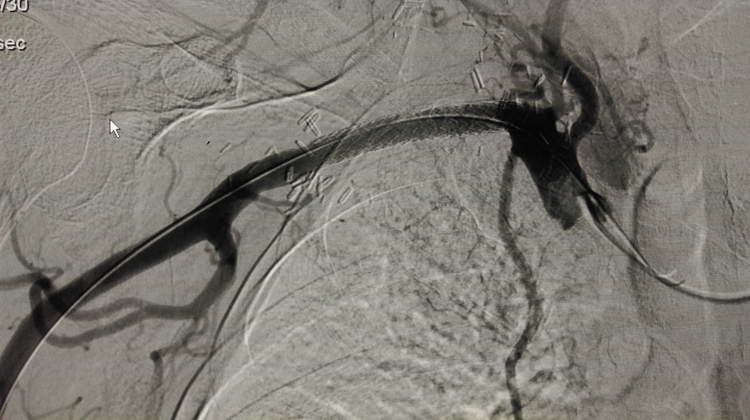Aneurysm is an enlargement of the part of the vascular wall. The most common cause of aneurysm is the deposition of fat particles in the vessel wall. Over time, the vessel wall loses its elasticity, and the impact of normal blood pressure in the aneurysm may cause the vessel to rupture.
The endoprosthesis (stent-graft) is woven polyester tube covered with a metallic frame is set in aneurysm without surgical intervention on the surrounding tissue of the affected vessel. This alternative treatment can be used in patients, who, for one or another reason cannot be applied to surgery. The stent-graft is used to strengthen the weakened vessel wall, preventing rupture of the aneurysm.
Subclavian artery aneurysm Positioning of the stent-graft
A patient K.Kh., 59-years-old, was admitted in 15.09.2015 to the Neck and Heart Vascular Surgery Department MC Erebouni with complaints of pulsating formation and spotting in the collarbone in the postoperative wound area (the patient was operated in February 2014: resection of the subclavian artery aneurysm with vascular prosthesis Vascutek 8mm). Based on the angiography results, were identified two false aneurysm in the distal and proximal regions of the imposed prosthesis. By the Head of the Neck and Heart Surgery Department Dr. M.P. Shatakhyan (MD,PhD) and invasive cardiologist Dr.Tzaturyan A.A. was made a decision of stenting with the covered stent-graft with involvement to the area of stenting the false aneurysm
The opening of the stent
In 07.10.15 was performed the selective angiography of the right subclavian artery by interventional cardiologist Dr. A. Tzaturyan.
Through the right radial access the stent-graft with diameter 8mm, length 59mm was inserted into subclavian artery, which under the angiographic control through the femoral access was implanted into the segment of aneurysmal enlargement. The stent-graft is a conventional stent, which is coated with Teflon sheath and is intended for the treatment of vascular perforations and closing of vascular aneurysm.
After implantation of the stent-graft Subtraction angiography of the brachiocephalic trunk
Repeated angiograghy shows that the stent-graft is completely closed the ostium of the aneurysm (as seen in the photo). While the blood flow in the right vertebral and internal thoracic artery hasn`t been violated.
The patient was discharged on 2 day after the surgery in a satisfactory condition.
Such intervention was carried out in Armenia for the first time and is possible only in such highly specialized hospital of multidisciplinary clinic.








